.
24.07.2015


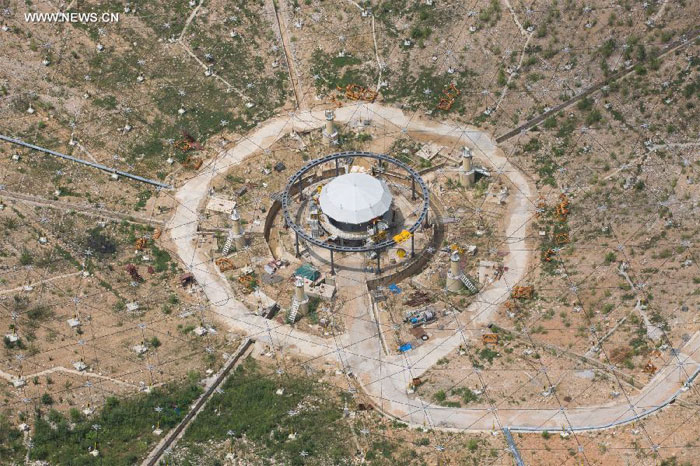

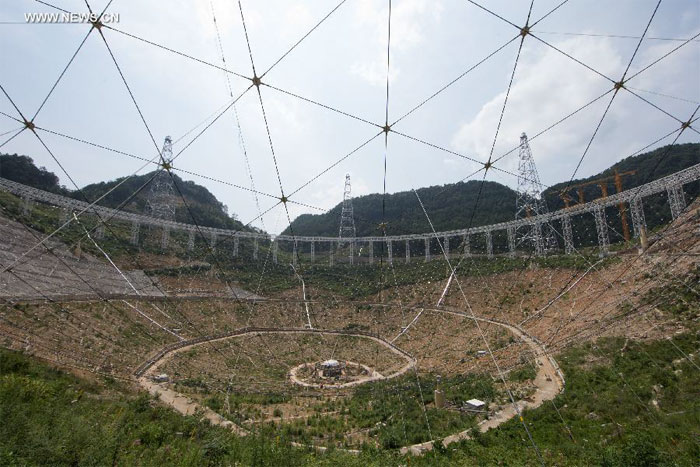
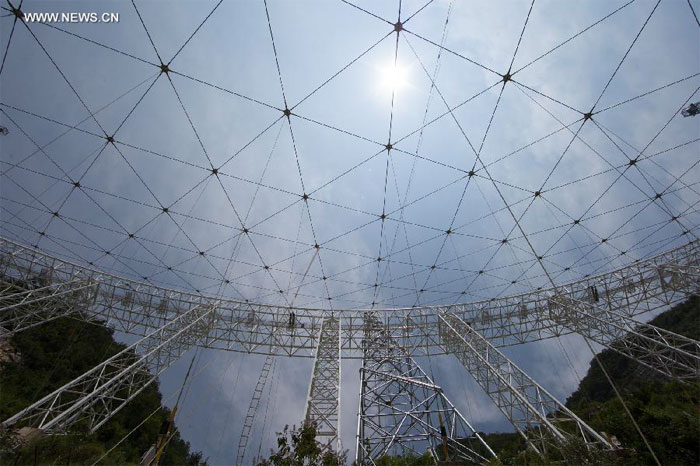

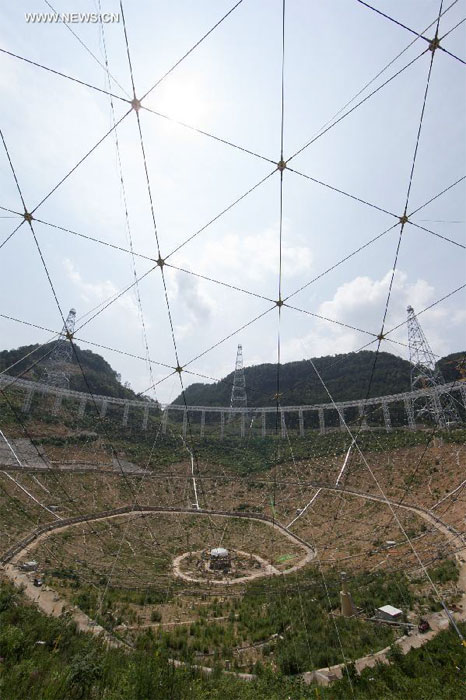

World's largest radio telescope nears completion

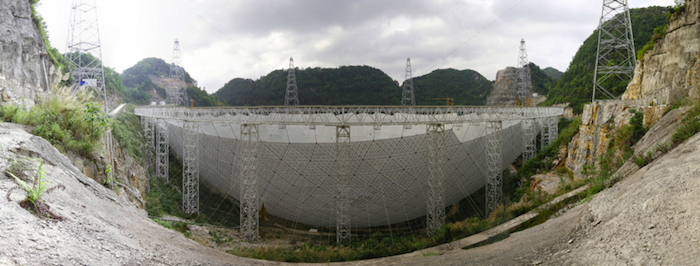


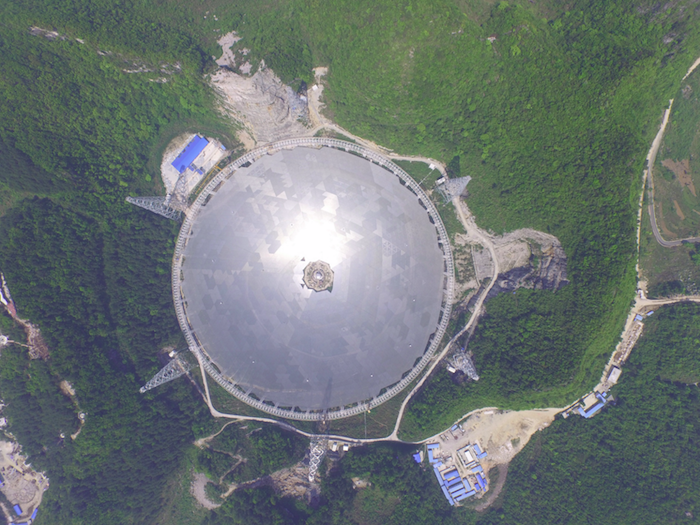

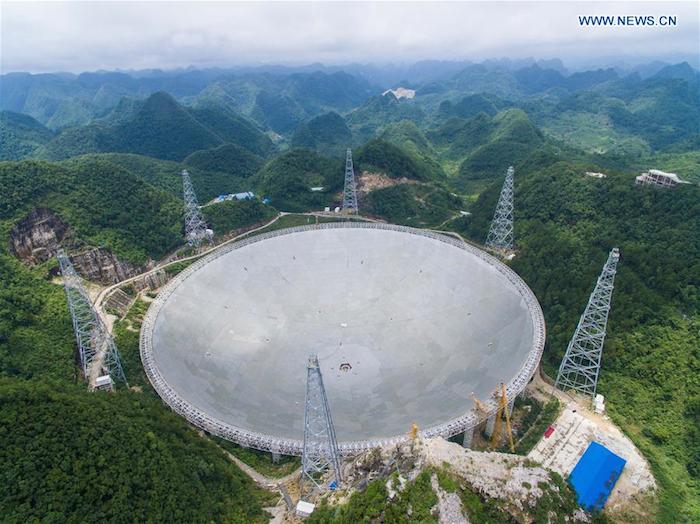
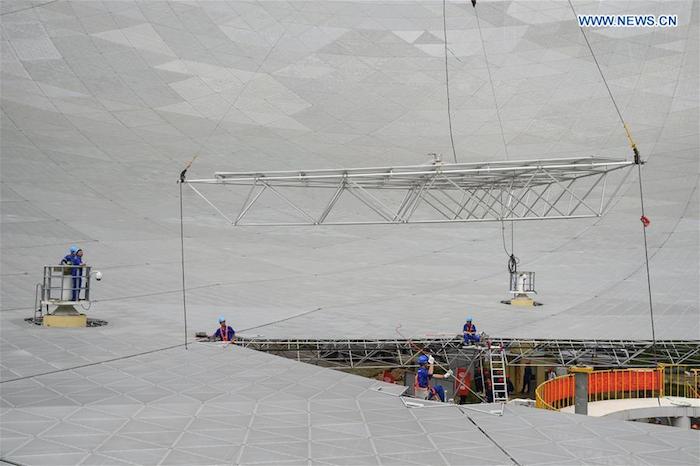
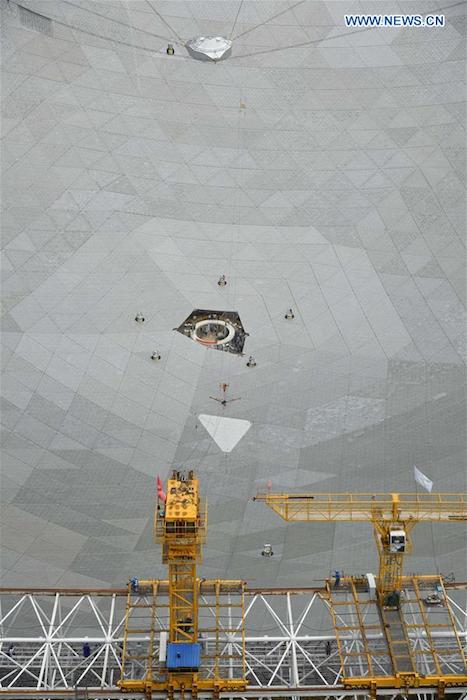
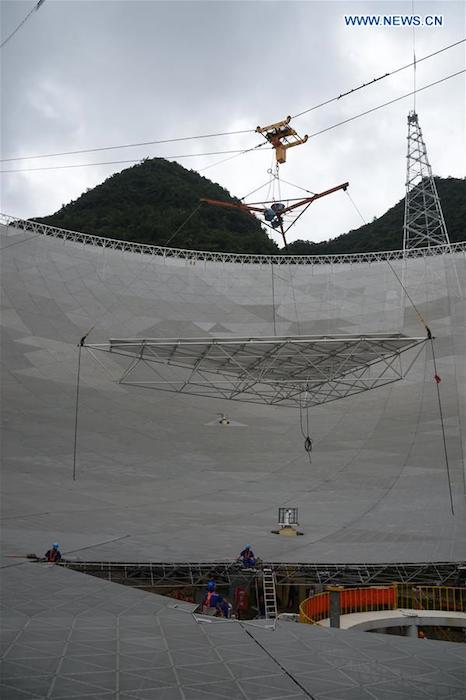



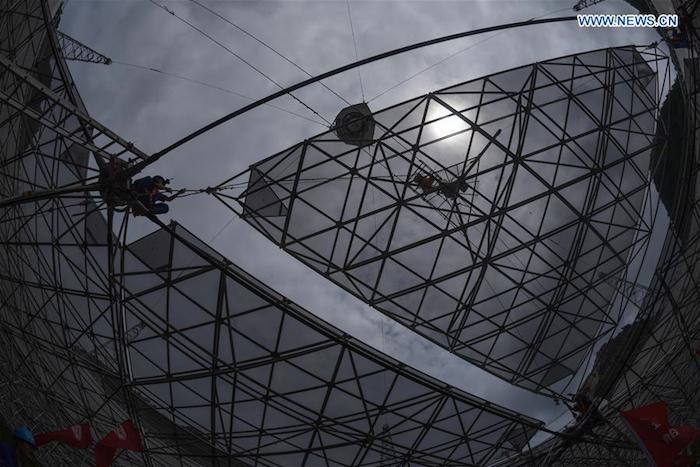
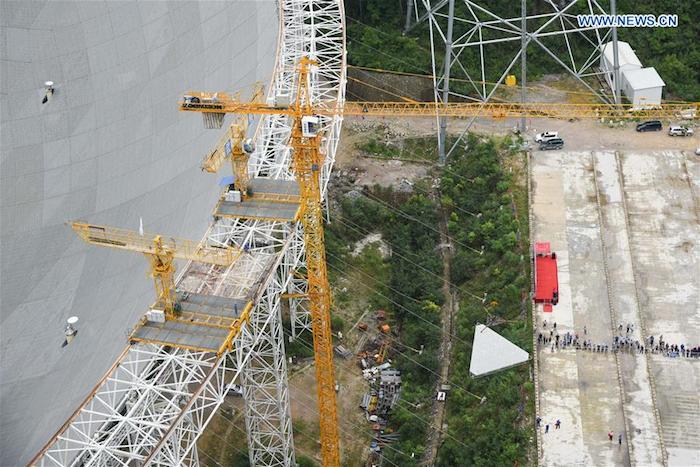





GUIYANG, The world's largest radio telescope was put into use on Sunday in a mountainous region of southwest China's Guizhou Province.
Shortly after noon, in a karst valley in Pingtang County, hundreds of astronomers and astronomy enthusiasts witnessed the official launch of the Five-hundred-meter Aperture Spherical Telescope's (FAST) mission to explore space and hunt for extraterrestrial life.
Work on the nearly 1.2-billion-yuan (180 million U.S. dollars) project started in 2011, 17 years after it was proposed by Chinese astronomers.
The installation of the telescope's main structure -- a 4,450-panel reflector as large as 30 football pitches -- was finished in early July.
"(The telescope) will certainly generate enthusiasm, bring people into science, and make China important in the world of science," Joseph Taylor, a Nobel Prize-winning astronomer at Princeton University, told Xinhua.
The astronomer was awarded the Nobel Prize in physics in 1993 for discovering indirect proof of gravitational waves with the assistance of Puerto Rico's Arecibo Observatory, home to a radio telescope that is 350 meters in diameter.
Taylor expects FAST to be a "productive" project, even if he is unsure whether any of its discoveries will lead to a Nobel Prize.
In fact, FAST has already had a good start. In a recent trial observation, it received a set of high-quality electromagnetic waves sent from a pulsar about 1,351 light-years away, said Qian Lei, an associate researcher with the National Astronomical Observation (NAO) under the Chinese Academy of Sciences, which built the project.
FAST's tasks include observation of pulsars as well as exploration of interstellar molecules and interstellar communication signals.
To ensure the telescope's performance, more than 8,000 locals are being resettled from their homes to make way for the project, which requires radio silence within a 5-kilometer radius. Visitors to the zone must turn off their mobile phones.
The telescope's leading engineer Wang Qiming said the telescope, designed and built by Chinese scientists, will remain the global leader for the next 10 to 20 years.
Yan Jun, head of the NAO, said China will roll out more "world-class" telescope projects in five to 10 years.
Quelle: Xinhua
---
China's giant telescope may lead to "discoveries beyond wildest imagination": U.S. expert
|
Photo taken on Sept. 24, 2016 shows the 500-meter Aperture Spherical Telescope (FAST) in Pingtang County, southwest China's Guizhou Province. The FAST, world's largest radio telescope, measuring 500 meters in diameter, was completed and put into use on Sunday. (Xinhua/Ou Dongqu) WASHINGTON, China's 500-meter Aperture Spherical Radio Telescope (FAST) may help better understand the origin and structure of the universe and accelerate and even revolutionize the search for life beyond Earth, a renowned U.S. alien intelligence expert said Saturday. FAST, the world's largest single-dish telescope with a diameter of a half kilometer, is expected to go online on Sunday. It is located at the Dawodang depression, a natural basin or "karst" in Pingtang County in the mountainous southwestern Chinese province of Guizhou. The telescope, nicknamed Tianyan, or the Eye of Heaven, can accurately image twice as much the sky as the Arecibo Observatory in Puerto Rico, which had previously been the world's largest single-dish radio telescope, with double sensitivity and five to 10 times the surveying speed. Douglas Vakoch, president of METI International, an organization promoting messaging outer space in the search for extraterrestrial intelligence, noted that astronomers worldwide will be invited to use the facility through a competitive review of observing proposals. "By opening FAST to use by the broader international community, China is demonstrating its commitment to fostering astronomy as a global scientific enterprise," he told Xinhua, saying it may lead to "discoveries beyond our wildest imagination." As for FAST's scientific missions, Vakoch said it will be used to look for the signatures of complex organic molecules in interstellar space, which will show how widely the basic building blocks of life are distributed throughout the cosmos. "For over a half century, astronomers have been using radio telescopes to answer the haunting question, 'Are we alone?' But astronomers face a daunting challenge: the signals they seek are so weak that an incredibly sensitive telescope is needed to detect them," he said. "FAST's innovative design and huge collecting area give it unsurpassed speed and sensitivity, making it vital to the search for extraterrestrial intelligence in the coming decades," said Vakoch. "We can expect China to become a world leader in the search for extraterrestrial intelligence because of its demonstrated commitment in building FAST." However, FAST will not initially be outfitted with the signal processing capabilities to search for aliens, he said. This technology will be added at a later stage, and when that happens, FAST will be able to scan the heavens for signals that "can't be created by nature, but only by advanced civilizations," Vakoch said. Based on the recent history of radio telescopes, he also predicted that FAST will lead to "a dramatic increase in the number and variety of pulsars discovered." Pulsars, one of FAST's main scientific objectives, are dense, rotating stars that act as cosmic clocks, emitting pulses with remarkable regularity. This could also provide scientists with the capability to detect gravitational waves, or ripples in space-time, from pairs of massive black holes, since FAST has the potential to precisely measure tiny changes of the pulsing rates of pulsars as the gravitational waves pass by. Vakoch highlighted FAST's role in underpinning China's space program, noting that China has made great breakthroughs in space exploration, such as putting humans into Earth orbit and having taikonauts to dock with an orbiting module as a first step toward developing a Chinese space station. "With the opening of FAST, China continues to demonstrate that it is a world leader in space exploration, now from an Earth-based observatory as well as from space," he added. "Astronomers around the world can be grateful to China for creating an observatory that may lead to discoveries beyond our wildest imagination." Quelle: Xinhua --- FAST telescope is put into operationCCTV.com China has completed the installation of its 500-meter Aperture Spherical Telescope, known as FAST. It's the largest such radio telescope in the world. FAST lies at a karst valley in Pingtang County of southwest China's Guizhou Province. Scientists and reporters are gathering at the completion ceremony. The telescope was independently designed and built by China. Quelle: CCTV --- 10, 9, 8 ... China prepares to flick the switch on world’s biggest telescopic eye on the skyWorld’s largest single-aperture radio telescope, with diameter of 500 metres, expected to help make major contributions to the understanding of the universe
China plans to switch on the world’s largest radio telescope on Sunday as it focuses much of its growing scientific ambitions on unlocking the fundamentals of the universe. Along with other massive facilities that Beijing plans to build, the telescope, which as a diameter of 500 metres, could entice international researchers to the country as it tries to catch up with the United States in generating discoveries. Officially named the Five-hundred-metre Aperture Spherical Telescope (FAST), the facility in Guizhou will replace the telescope at Puerto Rico’s Arecibo Observatory as the world’s largest single-aperture radio telescope. It will be an extremely good telescope for studying some areas of astronomy, especially for the study of pulsars and the distribution of galaxies in the local universe
Covering an area roughly the size of 30 soccer fields, it will scour a much bigger swathe of the sky than Arecibo for radio signals – including those possibly sent out by any aliens. “It will be an extremely good telescope for studying some areas of astronomy, especially for the study of pulsars and the distribution of galaxies in the local universe,” said Donald Campbell, professor of astronomy at Cornell University and former director of the Arecibo Observatory. Campbell said the telescope would make “significant contributions” to understanding the structure and history of the universe. China is yet to announce a research plan for the telescope, but an early-stage study focused on six topics, including galaxy structure and the formation of stars, according to the study’s website. The National Astronomical Observatories said the FAST team would not take media inquiries before the telescope’s launch on Sunday.
In its push to generate as much basic science as the US by 2020, Beijing has spared no effort in upgrading research facilities. The new telescope cost 1.2 billion yuan (HK$1.4 billion) to build, and an additional 1.8 billion yuan to relocate more than 9,000 residents from its site, state-run Xinhua reported. The relocation was to make sure that no one lived within 5km of the telescope. To protect it from radiation interference, people would not be allowed to use electronic devices, including mobile phones and digital cameras, if they entered the area, China Central Television reported. The Chinese government is willing to spend big money on basic research, which is good news for us
“The Chinese government is willing to spend big money on basic research, which is good news for us,” University of Hong Kong scientist Stephen Ng Chi-yung said. “It creates a lot of opportunities for astronomers all over the world.” Ng, who has been using telescopes in the US and Australia for his astrophysical research, said scientists from Hong Kong and elsewhere might head to China in the future to use its advanced facilities. James Cordes, also from Cornell, said he had been invited by fellow astronomers in China to use the FAST in his research on pulsars, gravitational waves and fast radio bursts. China also plans to build a 110-metre, fully steerable radio telescope in Qitai, in Xinjiang province, which will surpass the US’ Green Bank Telescope in West Virginia to become the largest of its kind in the world. Ng said the steerable radio telescope would be able to survey the part of the sky not covered by the FAST, which cannot be moved because the reflector is too heavy. We do not think of astronomy as a competition ... I’m happy to see China is part of the community
The site in Xinjiang was chosen in 2011, and a major research project for its construction was launched in April last year. It is unclear when construction will start. It is unclear when construction will start. Although the FAST will be one of the most advanced radio telescopes on earth, scientists say they need a wide range of telescopes covering different parts of the sky and radio frequencies to study the universe. “We do not think of astronomy as a competition,” Campbell said. “It’s the extensive collaboration throughout the world between astronomers using different telescopes. I’m happy to see China is part of the community.” Quelle: South China Morning Post |



